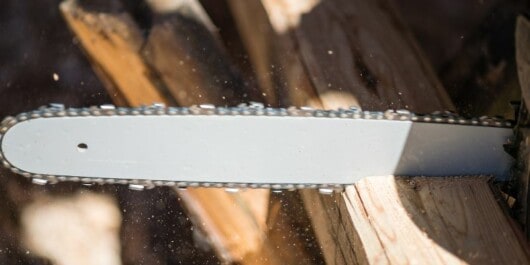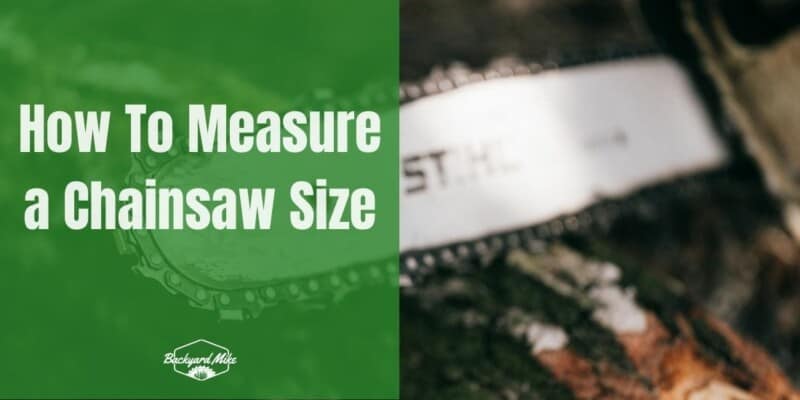Are you looking to change the chainsaw bar, but you’re struggling because you don’t know how to measure it in the first place? If so, then you are definitely in the right place.
Measuring a chainsaw size is quite easy if you know the right method. For measuring the chainsaw size, you will have to measure the length of the bar by holding the chainsaw up and using a ruler scale or tape for measurement. You must remember to measure the bar from the tip of the chain to the point where the chain is entering the chainsaw covering.
Lastly, you will have to round up the measurement to the nearest even number. You should never guess the length of your chainsaw bar. If you’re getting a replacement chainsaw bar based on guesses and assumptions, you’ll get a chainsaw bar that isn’t ideal for your chainsaw. Not only will it not work properly, but it’ll also end up damaging your chainsaw.
In this article, you will get to learn all about chainsaw sizes, how to measure a chainsaw size, when to replace the chainsaw bar, and more. Continue reading to get all the answers that you are looking for.
How to Measure a Chainsaw Size
A chainsaw can be the best friend of all forest workers and DIY homeowners. Undoubtedly, this tool can be a powerhouse if it is running smoothly. With repeated usage, your chainsaw will gradually wear out, especially the cutting part. This is why replacing the bar and chain will be necessary. However, finding the correct replacement size will be equally important.
To measure the length of the chainsaw bar, you should hold the chainsaw up and use a ruler scale or tape to take the measurement. You must always measure the chainsaw from the tip of the chain to the point where the chain is entering the chainsaw covering. After that, you will have to round up the measurement to the nearest even number.
You must remember that there are two types of measurements – the true length, which is the bar length, and the effective cutting length. Therefore, you must measure the true length of your chainsaw when you’ll be replacing the chainsaw bar.
How to Measure the Chainsaw Bar Length
Here are the step-by-step instructions on how to measure the chainsaw bar. Using this method, you’ll be able to find both the true bar length and the cutting bar length of your chainsaw. So, without further ado, let’s begin with the steps –
Step 1: Unplug the spark plug of your chainsaw
Before you start measuring the chainsaw chain bar length, you shouldn’t forget to unplug the spark plug. This way, you’ll be able to make sure that the chainsaw doesn’t accidentally when measuring the chainsaw bar. Place your chainsaw on the ground on a flat surface and make sure that the handle is facing up. Now, you’ll need to find the screws that are holding the cover of your chainsaw. You can loosen up those bolts with the help of a screwdriver or a wrench.
Moreover, you’ll need to find a black wire, which should be plugged into the circular port under the chainsaw casing. Remember to pull out the wire. It will disconnect the supply of power to the chainsaw casing. You shouldn’t be measuring the length of the chainsaw bar with the wire still connected to the spark plug. This way, the chainsaw could get started accidentally. The position of these bolts might differ depending on the type and model of the chainsaw you have.
Step 2: Measure the bar cutting length
The cutting length of the chainsaw is also referred to as the usable or effective length. Most of the average cutting lengths of a chainsaw are 14 inches (36 cm), 16 inches (41 cm), 18 inches (46 cm), and 20 inches (51 cm).
To take the measurement, you should place one end of the measuring tape at the point where the chainsaw bar is entering the body and extend the tape until it reaches the tip of the chainsaw bar. Measure the bar size and round off to the nearest possible even number, and this will be the accurate length of your chainsaw bar.
Step 3: Remove the chainsaw bar
For finding the actual length of your chainsaw bar, you will need to remove the clutch cover. There will be two nuts located on the right side of your chainsaw. They are responsible for holding the chainsaw clutch cover. You should unscrew the nuts with the help of a chainsaw and take off the chainsaw bar.
Once you have removed the nuts, you should take off the clutch casing slightly. This will expose the covered part of your chainsaw bar. Move the chainsaw bar in the forward direction gently before you pull off the chainsaw bar. This action releases the bar from the clutch.
Moreover, you shouldn’t forget to lock the chainsaw brake if your chainsaw has one. Otherwise, you’ll have difficulty removing the chainsaw bar. Remember to wear work gloves and follow the safety protocols as the chain is on the bar or you’ll accidentally hurt yourself.
Step 4: Measure the chainsaw bar to find the true length
Now, you should take the tape at one end of the chainsaw guide bar and extend the tape to the other end of the bar until its tip. This will give you the true length of the chainsaw bar. Lastly, you should round off the measurement to the nearest value, which will be the chainsaw’s true bar length. For instance, you must convert the 16 1/3 inches or 41 cm to 17 inches or 42 cm.
The standard chainsaw bar lengths will vary from 8 inches to 24 inches (20 cm to 61 cm). You should remember that the actual bar length should always be longer than the cutting bar length. If you’re confused about the measurement, you can take help from a chainsaw chain replacement chart. Alongside the size, you will also find out the type of chain that you need for your chainsaw from the chain measurement chart.
How to Measure a Chainsaw Chain
Now that you know the right way of finding the chainsaw bar length, it’ll be important to find out how you can measure the chainsaw chain. Remember, the chainsaw chain sizes will vary depending on the type and model of your chainsaw, so you’ll need to measure the size of your chainsaw before you purchase one for your tool. Here are the steps that you will need to follow to find the chainsaw chain length.
Step 1: Remove the chain
Before you find out how to measure chain size, you shouldn’t forget to remove the chain from your chainsaw. Doing this will make the chain measurement process easier. For this purpose, you will have to find and remove and remove the nuts holding the clutch cover. These nuts are usually located on the right side of chainsaws.
Once you have removed the clutch, you will be able to access the chain easily. You must pull the bar toward your side for releasing the tension. Remember to be gentle. After that, grab the chain and unloop it from the clutch carefully.
Step 2: Measure the chain pitch
Now comes the time to measure the chainsaw chain pitch. For this purpose, you should first put the chain on the ground or on a flat surface. This way, you will be able to easily see all the rivets. Rivets are essentially circular metal pieces that are responsible for holding together the chain links.
Using a measuring tape, you can measure the length of the chain easily. For this purpose, you should place the measuring tape at the edge of a rivet and pull the tape until the third rivet. Now, you need to divide the measurement by two, which is the chain pitch.
For instance, say that the distance between three consecutive rivets is 1.9 cm. In this situation, you should divide it by 2. The resulting 0.95 cm will be the pitch of your chainsaw bar. Generally, the chain will be mentioned on the right side of your chainsaw bar. Moreover, you can take the help of a chainsaw size chart if you’re confused about the chain size of your chainsaw.
Step 3: Use a caliper for finding the gauge of the chain
The gauge is used for defining the thickness of the drive links that fit into the bar. For finding the gauge, you should put a drink link between the jaws or caliper. Then, you should slide the jaws close to one another so that they’re able to grip the drive links. Now, you’ll be able to check the measurement on the caliper for finding the gauge.
If you aren’t able to measure the gauge, you can also find the gauge measurement on the size of your chainsaw. A standard gauge will be of different sizes like 0.05 inches (1.3 mm), 0.058 inches (1.5 mm), and 0.063 inches (1.6 mm).
You could use a dime, quarter, or penny in case you do not have the caliper. Easily slide any of them into the bar’s groove and check which measurement fits snugly. If the dime fits in, the gauge will be 0.05 inches. In the case of a penny, the gauge is 0.058 inches, whereas, for a quarter, the gauge will be 0.063 inches.
Step 4: Find the number of drive links the chainsaw chain has
The last step will be the measurement of your chainsaw drive links. Drive links are the pointed metal pieces present on the inner side of the chainsaw chain. You should put the chain on the ground or any flat surface and mark a dot on one of the links using a permanent marker.
Now, you should count the number of drive links that are starting from the link that you marked and continue along the chain length. You will need to count until you get to the drive link which you initially marked. Note down the exact number of the drive links.
The number of drive links will be mentioned on the side of your chainsaw bar, and it’ll be labeled as DL (drive links). There are chainsaw chain identification charts available that you can take help from if you’re having difficulty finding the right length of the chain.

Chainsaw Sizing Guide and Different Bar Sizes
Having the right-sized chainsaw will make cutting easier and much safer for you. Remember that the sizes of the chainsaw will vary depending on the chainsaw type, which makes them suitable for different projects.
The chainsaw bar sizes will vary from 12 to 20 inches, but you can even have a chainsaw with a bar size of as much as 72 inches. The professionals use chainsaws that have long bars, as they’re difficult to handle and only a professional is capable of handling them. The longer bar will also increase the weight of your chainsaw significantly.
When you’re selecting the chainsaw, you shouldn’t forget to check the chain size guide. The chainsaw chain chart will give you a clearer idea of the sizes. The experts also recommend going for a chainsaw with a bar at least 2–3 inches longer than the thickness of the wood you’ll be cutting. Here are the different types of chainsaws and the available bar sizes –
Electric chainsaws
An electric chainsaw comes with small-sized bars, usually around 14 to 16 inches. You can use these tools for felling small trees in your garden or cutting medium-sized trees in your backyard.
Gas-powered chainsaws
Gas-powered chainsaws generally have chainsaw bars of 16 to 18 inches. These chainsaws are suitable for felling medium-sized trees. If you need to cut large-sized trees, you can purchase a chainsaw having bars of 20 inches or longer. You will be able to use these chainsaws for cutting firewood.
Battery-operated chainsaws
Most battery-powered chainsaws come with bars of 16 to 18 inches. They will be perfect for felling or cutting small to medium-sized trees.
Small battery-operated chainsaws
These chainsaws are quite small in size. Most of the small battery-powered chainsaws come with bars of 6 to 9 inches. These chainsaws will be the best choice for homeowners who can make use of such tools for pruning small limbs.
When Should You Replace the Chainsaw Bar
The chainsaw bar can easily end up getting damaged from areas that you commonly use for cutting, including the lower edge. It is recommended that you should turn the bar on both shoulders such that it gets damaged evenly.
With time and regular use, you’ll feel that the burrs are created on the chainsaw bar, and you need to file them down. These burrs can damage your chainsaw if you do not file them. Therefore, you must file the chainsaw to equalize the two sizes of the grooves.
For proper maintenance and the long life of your chainsaw, you must inspect the chainsaw regularly. Normally, the depth of the sliding guide decreases gradually. If you’re using your chainsaw excessively, it can easily result in uneven wear, which will need replacement. For checking whether your chainsaw bar requires replacement, you must follow these steps –
- Put a finger on the chain after placing the chainsaw on a flat surface
- If the bar is swinging heavily, you’ll need to replace the blade
- Now, you’ll have to place a ruler between the chainsaw bar and the external sides of the chainsaw teeth
- If there’s a gap created, the chainsaw chain is in perfect condition
- If there isn’t, you will need to replace it
If you want to keep your chainsaw in good condition, and you wish to use it for a while, you must follow these precautions –
- Always check for the chainsaw tension before and after using the chainsaw. This will keep your tool from any unwanted wear and tear.
- Sharpen the chainsaw teeth regularly.
- Try to cut your chainsaw straight and never push the chainsaw towards any side.
- It is important to adjust the lubricating oil according to the type of wood you’ll be cutting.
- Use the chainsaw blade for cutting. You won’t be able to use it as a hammer or lever for felling trees.
Never Play the Guessing Game with Your Chainsaw
Since you now know how to measure a chainsaw size, it is recommended that you should never guess the length of the chainsaw bar. If you buy a replacement based on your guesses and assumptions, you’ll be getting a chainsaw bar that isn’t ideal for your chainsaw. Ultimately, you will end up damaging your tool, or you might get injured too.
Instead of guessing the length of the chainsaw and making a wrong decision, you should try to take out time to get accurate measurements.
FAQs
What size chainsaw do I need?
The chainsaw bar is the portion of the chainsaw that extends from the handle and contains the chainsaw chain. The length of the bar determines how big of a log or tree the chainsaw can cut. Chainsaw bars come in a wide variety of lengths. The most common sizes will be 16 inches, 18 inches, 20 inches, and 24 inches. For most homeowners, going for a 16-inch or 18-inch bar will be sufficient. You will require a chainsaw with a longer bar if you intend to cut large trees or longs.
What do the different numbers on a chainsaw bar mean?
The first number will be the length of the chainsaw bar in inches, whereas the second one will be the gauge or width of the chainsaw chain. For example, a 16-inch chainsaw bar with a 0.05-inch gauge will be written as 16-0.050.
What do you mean by the 325 on a chainsaw?
The 325 on the chainsaw refers to the pitch of the chainsaw chain. The pitch will be the size of the gap between the drive links of the chainsaw chain. Here, the pitch will be 3/8 inches, which is a common size for homeowner chainsaws.
Can I run a chainsaw without a bar?
Yes, it is definitely safe to run a chainsaw without a bar. However, doing this will significantly decrease the lifespan of your chainsaw and even cause kickbacks. Moreover, the chainsaw will be less effective when it comes to cutting and splitting wood.


